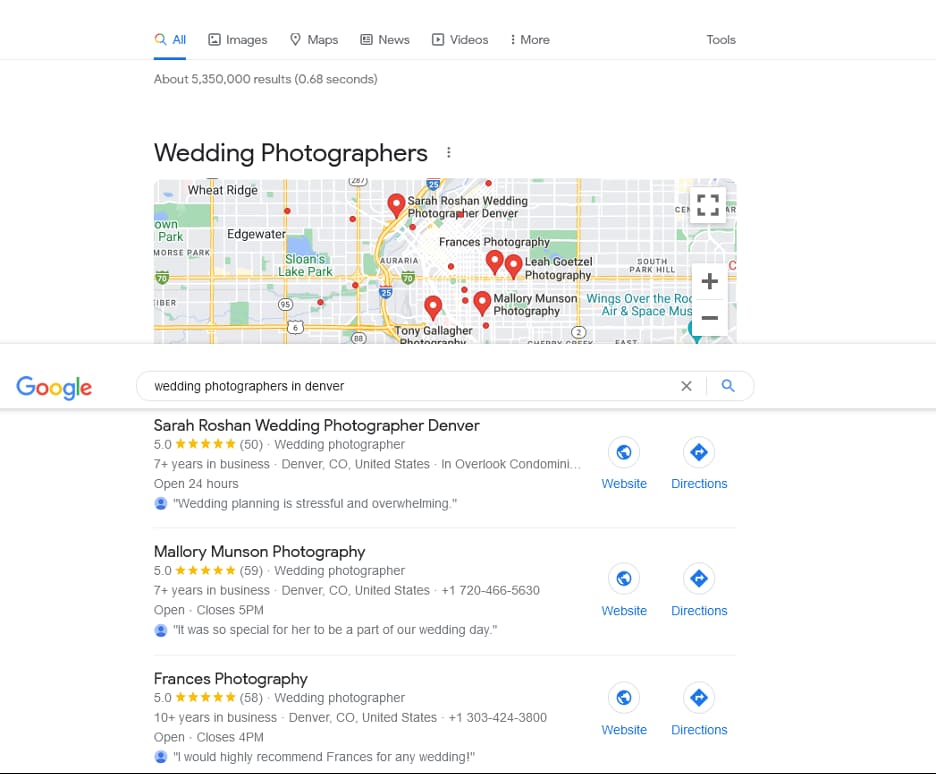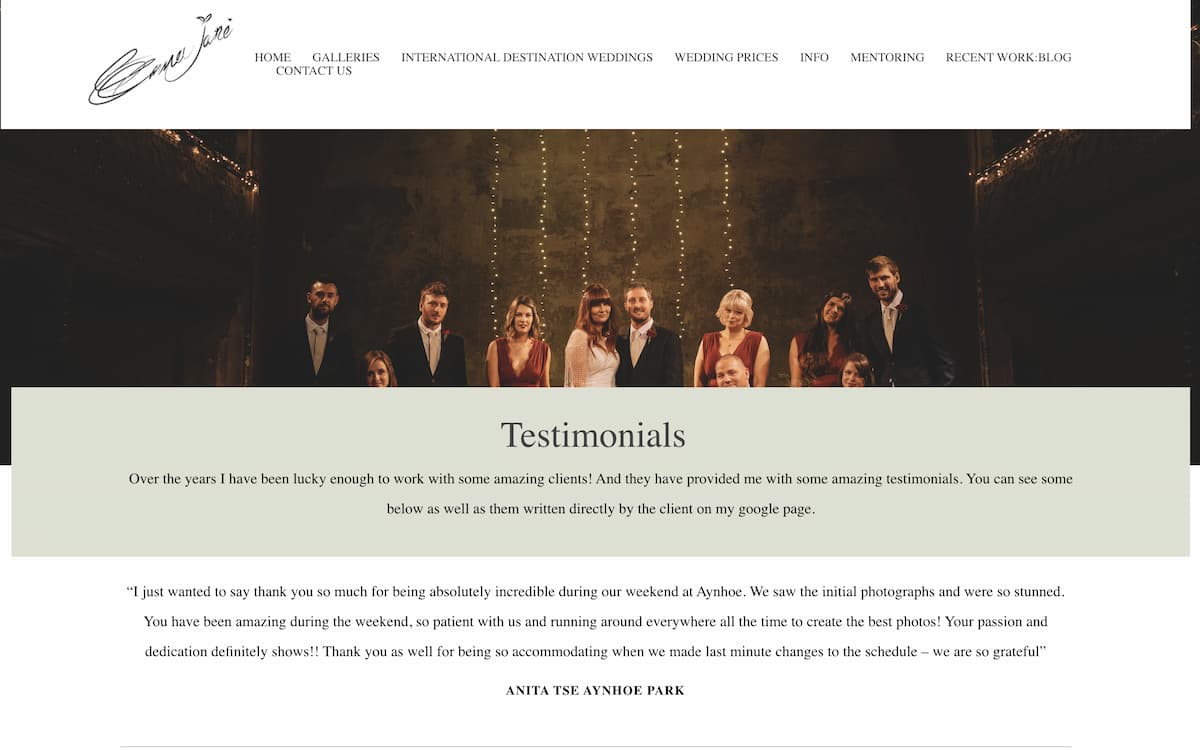How to Promote Your Photography Business: 11 Proven Tactics
14 min readYou probably take amazing photos and give your 100% when capturing memorable moments and breathtaking scenes. Now, monetizing your work might be another story.
Many amazing creators give up on their dream jobs because they can’t make a living with them and get bitter when they see mediocre works sell like hotcakes.
Don’t get bitter, get better — at promoting your work. Today, we’ll show you 11 rock-solid promotion tactics and photography marketing ideas which will land you among the stars.
11 tactics to promote your photography business:
- Build a great portfolio website
- Build an email subscriber list
- Network and collaborate with related professions
- List in local directories
- Google My Business: the best asset for local businesses
- Write SEO-friendly blog articles
- Build backlinks to your photography website
- Analyze your search performance
- Run PPC ads
- Be active on social media
- Get reviews and testimonials from current clients
Did you know? GetResponse marketing automation software comes packed with all the tools you’ll need to get your photography business off the ground. Build websites, collect email subscribers, send email campaigns, and sell digital products using one intuitive tool. Sign up for your 100% free account today.
1. Build a great portfolio website
Do you fumble through your works to find something acceptable each time someone asks to see your portfolio? It’s time to put an end to it! Not only does it make you look unprofessional and disorganized, but you might forget to show them your best photos — and eventually lose the gig.
The solution is easy: create an online photography portfolio to put an end to these situations, and show off your photography skills.
Not only you’ll have a selection of your best work ready in your online portfolio at all times, but:
- You’ll get a digital marketing asset that advertises your photography business online;
- Your professional, reliable website that doesn’t depend on slippery social media algorithms;
- You can present your work in the best quality possible — Instagram is infamous for ruining the photo quality;
- Anyone can discover your work and contact you at any moment, without you actively pushing for it;
- A photography website is an excellent marketing tool to promote your career further.
If you need an example of a professional-looking website, take a look at thelocals for inspiration. Their website checks all of the boxes above, while being classy, tasteful, but still unpretentious:


Worry not if you’re not very technical and don’t know how to code a website. Using tools like the Photography Website Builder from GetResponse you can create a website of your own, completely free, in a matter of moments.
You can either use their AI builder to create a website for you from scratch (after answering a few questions about your niche) or use one of their slick prebuilt website templates, some of which you can see below.

2. Build an email subscriber list
Now that you have your website and a portfolio to flaunt, it’s time to build an email subscriber list.
Why? Because email marketing is the most direct and affordable way to keep your audience informed about your photography business. Whether you’ve introduced new services, made an interesting photo shoot you’d like to show off, or got a new deal and want to start collecting bookings for it – you can communicate that to your email list.
Sure, building an email list from scratch takes time. But email marketing pays off tremendously as its ROI is 38:1, meaning for every $1 you invest you’ll get on average $38 in return.
To get those emails, place popups and forms on your website. There are several good, non-obtrusive ways to do so:
- Personalized CTAs on landing pages and blogs — Adjust the email subscription incentive to flow naturally with the web page.
- Place Scroll boxes strategically — Scroll boxes are excellent because they allow you to pick the best timing for email capturing. They can slide in after visitors go through a specific portion of content and are ready to take action.
- Create a popup form — Like with CTAs, your popup offers need to be relevant to the page. Make them timed, triggered by scrolling, or use exit-intent popups. Spin-the-wheel is an excellent way to gamify the popup!
- Use your social media — If you have accumulated a solid social media following over the years, use it to propose your followers subscribe.
- Make these forms entertaining — Don’t be afraid to spice it up with some puns, witty lines, or mild and self-aware sarcasm. As long as it’s not offensive and matches your brand, it can’t do you wrong.
But, you need to give them a reason for leaving you their email address.

A “tit-for-tat” strategy is a surefire way to gain more subscribers — that’s where subscription incentives (also known as lead magnets) step into the picture. Try discounts and gifts, or opt for digital products such as ebooks, whitepapers, CC0 images, and exclusive content for subscribers.
3. Network and collaborate with related professions
Community is everything, and as a professional photographer, you should build yours day by day. Depending on your area of expertise, you’ll need to nurture relationships with plenty of other professionals:
- Food photographers work with pastry chefs, cooks, restaurant owners and managers, and even sellers from the farmers’ market.
- Fashion photographers should hang out with fashion designers, models, and media personnel.
- Wedding photographers have a rich pool of connections, from makeup artists, decorators, and wedding planners, to florists and wedding hall owners.
You get the gist. Word of mouth is powerful and, in many cases, will help you book more clients.
If you’re unable to make friends IRL while networking at industry events, you can do it online:
- Hype them on social networks — Because kindness and solidarity are free. Share their work and give them a shoutout from time to time, and people will return the favor.
- Exchange referrals with fellow photographers — Agree to recommend each other when the opportunity arises.
- Display each other’s work/ads — Use each other’s websites and social media profiles to showcase and recommend works and services.
- Guest blogging — Offer to write for their blog and leave some space for their blogs on your website. This way, you will expose your work to an entirely new audience.
Photographer Mijoo Kim collaborated with imma, a virtual influencer, creating an interesting project which marries photography, AI, and digital arts, placing virtual reality in a tangible setting:

4. List in local directories
While they’re not quite as influential as they once were, local directories are still used in 2022.
They’re not only a source of free backlinks which can boost your SEO performance overall, but you’re likely to get referral traffic too. Many directories rank in Google for local photography keywords.
Here’s what the SERP currently looks like for a local town search, ‘photographers Middlesbrough’:

4 out of 5 of these results are directory pages. So if you’re looking for photography work in Middlesbrough, you’d best make sure you’re getting listed in these places!
Most directories will allow a free listing, but have paid upsells to offer too, such as paying extra for a higher position in the results. Others offer pay-per-click or pay-per-lead models too; you’ll need to research it case by case.
Here are some examples of free & paid directories you where could list your photography business:
You can also search for niche-specific directories, like wedding or event suppliers.
5. Google My Business: the best asset for local businesses
Even higher than directories in the Google search results, there are Google My Business listings. Sometimes referred to as the ‘map pack’. Unless people have a recommendation, it’s highly likely that this is how local prospects would search for a photographer.

This is a condensed explanation of the setup, but there are two initial steps to get listed on Google My Business:
- Set up your account — This is where you’ll add the basic info (pro tip: select “I deliver goods and services to my customers” followed by “Hide my address” if you don’t have a business address);
- Verify your business — Google will provide you with a verification code, and upon verification, you’ll be able to use the account.
After that, it’s time to optimize your Google My Business account.
Positive reviews and high-quality photos will matter the most to your potential customers, and they’ll influence your Maps ranking too. Upload some of your best materials, and kindly ask satisfied clients to help you with ratings. To prove your credibility further, add a local phone number so people can reach out with just a tap or a click.
To learn more about optimizing your Google My Business profile, consider reading this guide from Search Engine Journal.
6. Write SEO-friendly blog articles
One limitation of focusing only on Google My Business rankings is that you’ll only appear when someone searches specifically for a photographer. That’s valuable, of course, but there are many other search terms that might capture potential customers. That’s where writing blog posts come in.
To get some ideas for SEO-driven blog articles, the best thing to do is to see which keywords other photographers are driving traffic from. Let’s take an example of wedding photographers using Susan Shek’s website. By entering the URL into Ahrefs, I can see her top traffic-generating pages:

- Wedding tradition keywords e.g. ‘jewish wedding traditions’
- Venue-focused keywords e.g. ‘the plaza new york wedding’
- Informational searches e.g. ‘marriage ceremony nyc’
All of these searches indicate that the searcher could potentially be getting married, and therefore in the market for a wedding photographer.
It’s worth noting that Ahrefs can be a little pricey (starting at $99/month). There are some alternatives to Ahrefs that are cheaper, such as SE Ranking or Mangools which can perform similar functions.
Every blog post and article you publish should be three things:
- Localized — Clients won’t always be keen to fly you to their location. Make sure to localize your content, so people who are reasonably distanced can find you, and you can travel to their site without hefty expenses.
- Seasonal — Not just SS/FW; think of trends, holidays, and events. Connect your blog themes with current affairs to score clients year-round.
- Beneficial to your clients — Here’s an easy example: if you’re a wedding photographer, write about topics that appeal to brides and grooms-to-be.
Now that we’ve covered that, let’s list the essential elements of an SEO-friendly blog article:
- They’re rich in relevant keywords.
- Text is divided between several subtitles and follows the header tags hierarchy: H1 for the title, H2 for most important, H3, H4, and so on to provide structure.
- Each paragraph holds a singular idea and no more than five sentences.
- Sentences are easy to read and digest.
- Each image contains alt text that correctly describes it in 125 characters or less, with keywords sprinkled in.
Illustrate each article with your work. Apart from giving genuinely helpful advice, each blog should hint that hiring a pro (you) to take care of things and create beautiful images is easier.
It can take some time to get your blog off the ground, but once you nail your content creation process, things do start to get faster. You can even outsource it to scale up your efforts.
If you’re looking for inspiration, Liam + Bee are wedding photographers with an amazing blog. It’s topically sectioned and covers the usual themes couples are interested in:

To make things more personal and romantic, there are plenty of blogs putting couples in the spotlight — catering to all the moods and styles:

7. Build backlinks to your photography website
Backlinks can be viewed as an ‘upvote’ to Google. Typically, the more websites that are contextually linking to your site, the more chance you have to rank in Google. So after you’ve produced all those great pages, building backlinks will help them to rank.
But not all links are made equal.
Like with article topics, the websites providing backlinks should be locally and topically relevant. Think of local pet stores, veterinary clinics, pet daycares, and pet sitters if you specialize in pet photography. Or simply blogs about pet-related topics.
The second important thing is that these sites have good domain authority. There’s no hard and fast rule for what you should aim for, but typically higher is better (as long as it’s still relevant). You can check the website’s domain authority using tools like Ahrefs mentioned above, or here’s a free option for checking domain authority too.
8. Analyze your search performance
After all the work, it’s time to analyze your marketing efforts and learn if search engines connect you to your ideal clients.
There are two essential tools you should use to track the results, improve, and come up with unique marketing strategies:
- Google Analytics — This shows how your site visitors interact with your website; statistics display site visits, average time spent on your website, bounce rate, and other website usage data. You can use it to run Google Ads and look into current trends to ride and increase traffic.
Just a note: Google has recently introduced Google Analytics 4, and some Google Analytics changes are expected. - Google Search Console — This tool is keyword-oriented: it shows clicks, impressions, click-through rates, backlinks, and crawl and HTML errors. These metrics help you improve the website’s SEO, and Google Search Console helps users by identifying issues and suggesting how to fix them.
To top things off, consider using rank tracking tools to monitor your impact. If you have an all-in-one tool like Ahrefs or Semrush, there are rank tracking features built-in. If that’s too much for you, you can use a standalone rank tracker which has fewer features, but is cheaper.
For example, I use Nightwatch’s rank tracker, which starts from around $33/month. It includes map rankings which is helpful for you as a photographer and just gives a straightforward overview of your keyword positions/trends.
9. Run PPC ads
Pay-per-click advertising extends your organic marketing efforts — sometimes inevitable to boost your work effectively.
While search results don’t always show ads, there are times when your page won’t even get noticed if you don’t invest in ads. Consider this SERP for the keyword ‘business photoshoot london’, where the first screen is completely filled with ads.

So after you’ve done everything to get your website, social media profiles, and landing pages in top shape, set the campaign budget. The financial resources will dictate the course of your campaign.
If this is your first time working with paid advertising and both your experience and budget are low, manual bidding is the best strategy to start with. With manual bidding, you get to manually set the cost of each click on your ad (hence the name), but you can’t optimize the campaign once you set it off.
Keyword research is the most important part of a PPC campaign. Think of the terms your potential clients would use to find you; here are some more tips:
- Use specific and local terms for precision.
- Snoop the competition for ideas.
- Select negative keywords to filter out the unwanted clicks.
- Create attention-grabbing ad copy.
To learn more about paid ads, read this Google Ads Best Practices guide and How to Create Google Ads in GetResponse.
Most people probably describe “being active on social media” as liking, sharing, posting, and commenting, with algorithms in mind.
That won’t be enough if you want to build a powerful social media presence and harness the possibilities of social media. You should also:
- Participate in trends and seasonal events — Halloween photoshoots, anyone?
- Track changes in rules and algorithms — What worked a year ago may not serve you right now. Social media platforms change the way they work from time to time, and you should be aware of all the shifts (and take advantage of them).
- Tag and mention people in your posts — As a part of your relationship-building strategy (see part 4) keep in touch with other professional photographers and related creative professionals.
- Collabs are the way to go — Much like with guest posts, collaborations are a great way to get in touch with a completely new audience. Account takeovers and live sessions are entertaining as well.
If you’re new to social media from the business perspective or are looking for inspiration, check out this list featuring top photographers to follow.
11. Get reviews and testimonials from current clients
When someone vouches for the quality of your work personally, with their name and reputation at stake — you know your work truly has value, and that’s when others believe it too!
Still, plenty of people are shy and hate asking for testimonials, as if they’re fishing for compliments. If they told you they loved working with you, especially if they keep coming back, there’s no reason to refrain from asking for reviews!
To make things easier, we’ve created this simple quote you can personalize and send to your existing clients:
“Hi (client name),
It was so good working with you on (project name)!
I was wondering if you’d like to send a testimonial/review of my service; I’d like to include it on my website and social media.
I hope we’ll work together again soon!
Best,
(your name and signature).”
See? It’s not that hard! You can do it on autopilot and receive testimonials with even less effort with some email marketing automation.
Once your receive testimonials and reviews make good use of them:
- Post them on social media with some story-telling: describe the project you worked on, and add some candid BTS shots;
- Install a testimonial & review carousel on the website;
- Create a dedicated page for success stories and client quotes.
You can get more than quotes: testimonials also come as videos, blog reviews, star ratings, and user-generated content (their social media posts about your service).
Here’s an example of how one photographer, Emma Jane, features her reviews on her website.

And how the reviews on her Google My Business page help her appear at the top for the term “best photographer london”:

Summary
You should use all means of promotion to get your name and work out there — free and affordable.
Here are the most important tactics for doing so:
- Create a powerful website to display your photographs in full quality; use it as a portfolio, and to bring organic traffic with SEO-friendly content rich in backlinks.
- Be locally relevant and connect with other industry professionals so they can recommend you.
- Learn how to use marketing analytics tools and PPC ads to increase your visibility.
- Use social media regularly and to its fullest; it’s a no-brainer, but remember to stay on top of the algorithms and trends, and socialize with people and your followers.
These tactics are proven to work: some of them instantly, some take time, but all pay off and are worth your time!




